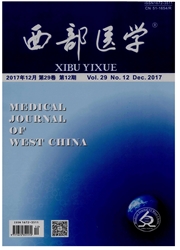

 中文摘要:
中文摘要:
目的探讨肱三头肌舌形瓣入路和肘前肌间隙入路两种手术方式在治疗小儿肱骨髁上骨折的临床效果。方法选取2012年3月到2014年1月我院骨科收治的肱骨髁上骨折患儿106例,按照随机数字表法将所有病例分为治疗组和对照组各53例。治疗组患儿采取经肘前肌间隙入路进行手术,对照组则采用肱三头肌舌形瓣入路进行手术,两组患儿均采用交叉克氏针进行固定复位,同时使用石膏托进行外固定。分析两组患儿相关的手术指征等情况,并根据视觉模拟评分(VAS)和疗效评价标准对患儿的疼痛程度及治疗效果进行评价。结果治疗组患儿的手术时间、术中出血量、术后石膏外固定时间以及术后4天内的疼痛程度均明显少于对照组,差异具有统计学意义(P均〈0.05)。治疗后半年对所有患儿进行随访,治疗组患儿的优良率为94.34%,对照组为60.38%,治疗组的术后恢复情况明显好于对照组,差异具有统计学意义(P〈0.05)。结论经肘前肌间隙入路对小儿肱骨髁上骨折进行治疗,操作简便,手术时间较短,术中出血量较少,能够有效减轻患者疼痛,术后恢复情况良好,可将其作为治疗小儿肱骨髁上骨折的首选手术方法并在临床推广应用。
 英文摘要:
英文摘要:
Objective To research the clinical effects of the triceps tongue shaped flap approach and the anterior elbow muscle gap approach in supracondylar fracture of humerus in children. Methods 106 children with supracondylar fracture of humerus were selected in the department of orthopedics in our hospital. According to the random number table method, all cases were divided into the treatment group and the control group. The treatment group was treated by the anterior elbow muscle gap approach. The control group used the triceps tongue shaped flap approach. Two groups of children were using the cross Kirschner wire fixation reduction, also given external fixation by plaster cast. According to visual analogue scale (VAS) and curative effect evaluation standard, the degree of pain and the therapeutic effect in chil- dren were analyzed. Results The operation time, bleeding volume, postoperative piaster external fixation time and the degree of pain within 4 days after surgery of the treatment group were significantly better than that of the control group. The difference was statistically significance(P~0.05). After treatment for six months,the follow-up survey was per- formed in all children. The excellent and good rate of treatment group and control group were 94.34% and 60.38~. The recovery of the treatment group after operation was significantly better than that the control group, the difference was significant, with statistical significance(P〈0.05). Conclusion The anterior elbow muscle gap approach for treatment of supracondylar fracture of humerus in children can shorten the operation time, decease the amount of intraoperative bleed- ing and reduce the pain of patients, which can be used as the preferred method for treatment of children with supracondy- lar fracture of humerus.
 同期刊论文项目
同期刊论文项目
 同项目期刊论文
同项目期刊论文
 Fumosorinone, a novel PTP1B inhibitor, activates insulin signaling in insulin-resistance HepG2 cells
Fumosorinone, a novel PTP1B inhibitor, activates insulin signaling in insulin-resistance HepG2 cells Paecilomycines A and B, Novel Diterpenoids, Isolated from Insect-Pathogenic Fungi Paecilomyces sp AC
Paecilomycines A and B, Novel Diterpenoids, Isolated from Insect-Pathogenic Fungi Paecilomyces sp AC A novel oxybis cresol verticilatin with highly varying degrees of biological activities from the ins
A novel oxybis cresol verticilatin with highly varying degrees of biological activities from the ins Three New Pigment Protein Tyrosine Phosphatases Inhibitors from the Insect Parasite Fungus Cordyceps
Three New Pigment Protein Tyrosine Phosphatases Inhibitors from the Insect Parasite Fungus Cordyceps 期刊信息
期刊信息
